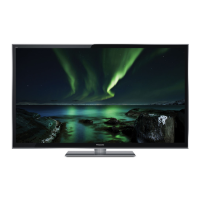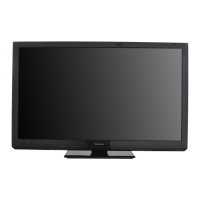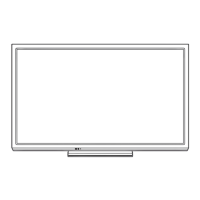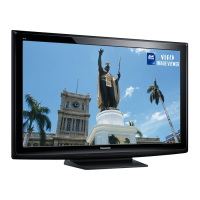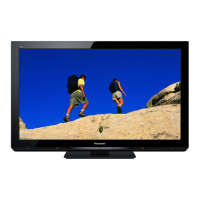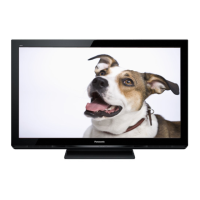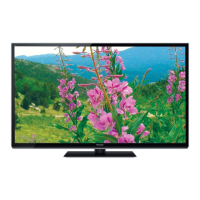26
Using Precautions
• Liquid Crystal Shutter
• Do not apply pressure to the liquid crystal shutter. Also, do not drop or bend the 3D Eyewear.
• Do not scratch the surface
of
the liquid crystal shutter with a pointed instrument etc.
Doing so may cause damage to the 3D Eyewear, and reduce the quality
of
the 3D image.
• Infra-red receiver section
• Do not soil the infra-red receiver section or attach stickers etc. to
it.
•
Doing
so
may
prevent
the
receiver
from
receiving
signals
from
the
television,
which
may
prevent
the
3D
Eyewear
from
operating
normally.
• If the
3D
Eyewear
is
affected
by
other infra-red data communication equipment, the
3D
images
may
not
be
displayed correctly.
• Cautions During Viewing
• Do not expose the infra-red receiver section to strong light such as direct sunlight and fluorescent light. The 3D image
may not be displayed correctly.
• Do not use devices that emit strong electromagnetic waves (such as cellular phones or personal transceivers) near
the 3D Eyewear. Doing so may cause the 3D Eyewear to malfunction.
• The 3D Eyewear cannot operate fully at high or low temperatures.
Please use within the specified usage temperature range (p. 67).
• If the 3D Eyewear is used in a room in which fluorescent lights (50 Hz) are used, the light within the room may appear
to be flickering. In this case, either darken or switch off the fluorescent lights when using the 3D Eyewear.
• Wear the
3D
Eyewear correctly.
3D
images will not
be
correctly visible if the
3D
Eyewear
is
worn upside down or back-to-front.
• Other kinds of displays (such as computer screens, digital clocks, or calculators etc.) may be difficult to see while
wearing the 3D Eyewear. (The polarizing axis does not match, causing the displays to appear black.)
Do not wear the 3D Eyewear when watching anything other than 3D images.
•
Individual
differences
may
occur
in
which
the
3D
images
are
difficult
to
see,
or
cannot
be
seen,
especially
in
users
that
have
a different
level
of
eyesight
between
the
left
and
right
eyes.
Take
the
necessary
steps
(wearing
glasses
etc.)
to
correct
your
eyesight
before
use.
• For comfortable viewing
• View the screen at a distance at least 3 times further than the effective height
of
the screen.
Recommended distance:
For a 55-inch television, 6'8" (2.1 m)
or
more.
Using the 3D Eyewear at a distance closer than the recommended distance may cause eyesight fatigue.
When the top and bottom area
of
the screen is blackened, such as during some movies, view the screen at a distance
3 times further than the height
of
the actual image. (That makes the distance closer than above recommended
distance.)
• Viewing 3D images
• When watching 3D movies, take an appropriate length break after watching a movie.
• When watching 3D content on interactive devices such as 3D games or computers, take an appropriate length break
after using for 30 - 60 minutes. Prolonged use may cause eyesight fatigue.
Viewing
3D
images
Using the television menu controls, set so that 3D images are shown.
• You can watch 3D images in the following cases:
• When a 3D image supporting Blu-ray Disc is played on a 3D image supporting player/recorder connected using a
HDMI cable to a 3D image supporting television.
• 3D image supported broadcast (program)
• 3D Photo, 3D Movie taken by LUMIX/Camcorder.
• 2D->3D (Simulated 3D)
..
p.
58
O
Wearing the 3D Eyewear
CD
Set the power switch to "ON".
(The indicator lamp will light for approximately 2 seconds, then flash once approximately every 2 seconds.)
® Put on the 3D Eyewear
View
When the HDMI receives information
in
which 3D mode is detected, 3D images are automatically displayed
according to the signal.
If
the 3D images are not displayed correctly or the images cause discomfort, the images can be adjusted by "3D
format select"
or
"3D settings".
• Change the view
3D~2D,
3D settings (p. 27)
After Use
CD
Set the 3D Eyewear power switch to "OFF".
(The 3D Eyewear indicator lamp turns off, and the power turns off.)
®After using the 3D Eyewear, store it in the case provided.
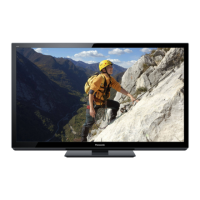
